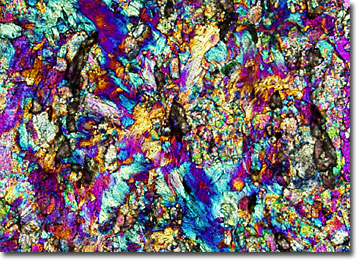Polarized Light Microscopy Digital Image Gallery
Eclogite
Eclogites are a small group of rocks that are predominantly composed of green pyroxene interspersed with red garnets. They also typically contain, however, small amounts of other minerals, such as olivine, rutile, and kyanite.

Eclogite is formed when igneous or metamorphic rocks that contain significant amounts of mafic minerals are exposed to pressures that exceed 1.5 gigapascals and high temperatures. Though chemically similar to basalt, the appearance of eclogite is quite distinct, being significantly more colorful than many other types of rocks. Thus, the coarse- to medium-grained green and red (sometimes pink) mineral matter is relatively easy to identify, even to those with an untrained eye. Typically present on Earth in small blocks or bodies, some of the best-known occurrences of eclogite are found in California, Norway, South Africa, Scotland, and the Alps.
Scientists have been studying eclogite for many years, and some have come to the conclusion that the rock is likely characteristic of large areas of the Earth’s upper mantle. Evidence for this view has been drawn from a variety of sources, including examination of eclogite intrusions, as well as laboratory simulations of the conditions that would be involved in the creation of such sizeable masses of eclogite within the planet. Investigators have also been intrigued by the fact that the composition of eclogites is notably similar to that of the stony meteorites called chondrites.
